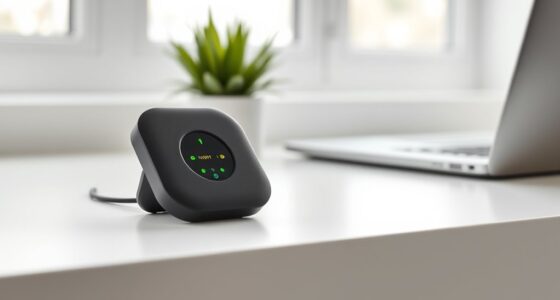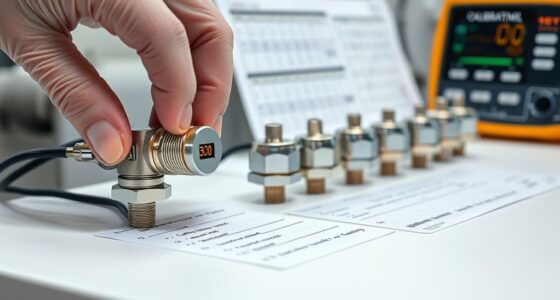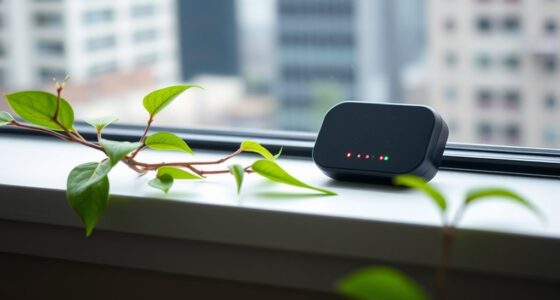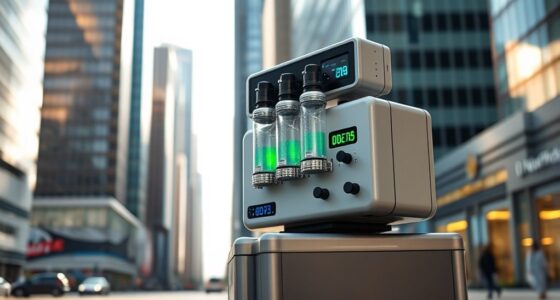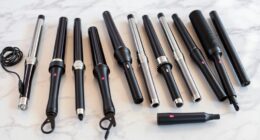To integrate IAQ sensors into smart building systems effectively, you need to guarantee proper calibration and strategic placement for accurate data. Seamlessly connect sensors using compatible communication protocols to enable real-time data flow. Use automation to trigger HVAC adjustments or air purification based on sensor readings, and visualize data to identify trends. When you focus on calibration, integration, and proactive responses, you’ll create healthier environments. Keep moving forward, and you’ll discover more about optimizing your system’s performance.
Key Takeaways
- Ensure sensors are properly calibrated regularly to maintain measurement accuracy within the smart building system.
- Use compatible communication protocols (e.g., BACnet, Zigbee, Wi-Fi) for seamless data integration.
- Strategically place sensors to accurately reflect indoor air quality, avoiding pollutant sources and drafts.
- Automate HVAC and air purification responses based on real-time sensor data and predefined thresholds.
- Utilize data visualization and analysis tools to monitor trends, optimize system performance, and maintain healthy indoor environments.
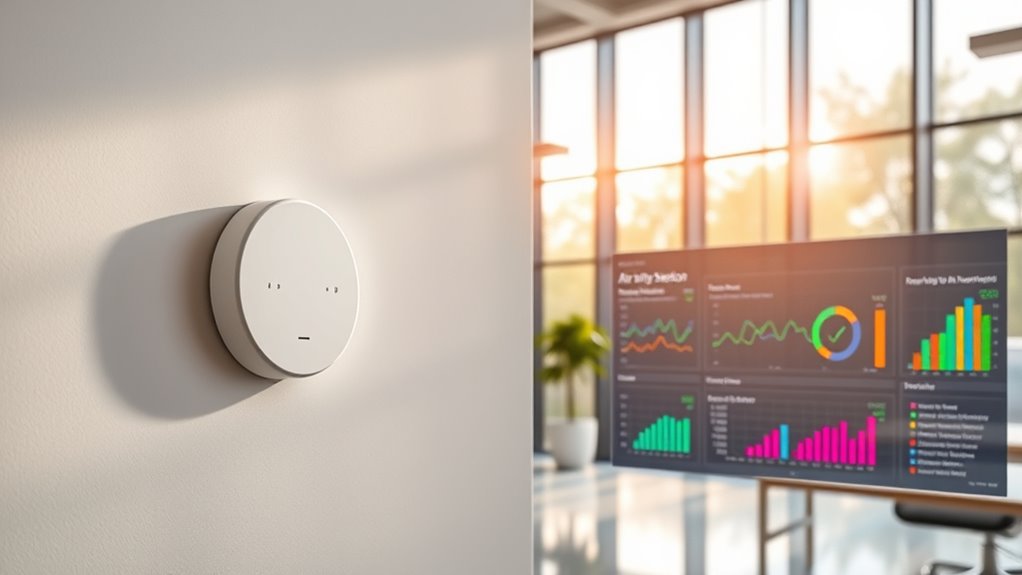
Integrating Indoor Air Quality (IAQ) sensors into your building management system is an essential step toward creating healthier indoor environments. When you connect these sensors, you’re equipping your system with real-time data that helps monitor and improve air quality effectively. But to get the most accurate readings, proper air quality calibration is crucial. Calibration ensures that the sensors provide precise measurements by adjusting their output to match known standards. Without this step, you risk relying on faulty data, which can lead to ineffective responses or unnecessary energy use. Regular calibration checks should be part of your maintenance routine to maintain sensor accuracy over time.
Proper calibration of IAQ sensors is vital for accurate indoor air quality monitoring.
Sensor data integration is the backbone of a truly smart building. It involves collecting, consolidating, and analyzing data from multiple IAQ sensors spread throughout your space. The goal is to create a comprehensive picture of your indoor environment. With seamless data integration, your building management system can make informed decisions—whether that’s increasing ventilation, adjusting HVAC settings, or activating air purifiers. The key is to ensure that the data flows smoothly from sensors to your control platform without delays or errors. Using compatible communication protocols and centralized data platforms simplifies this process, allowing for quicker response times and more reliable monitoring.
When you integrate IAQ sensors into your system, pay attention to the setup process. Proper placement of sensors is vital; they should be installed where air circulation is representative of the space, avoiding direct exposure to pollutants or drafts. Once installed, calibrate each sensor to ensure it provides accurate readings. Many sensors come with factory calibration, but environmental factors can affect their accuracy over time. Regularly reviewing sensor data and recalibrating as needed helps maintain reliability. Additionally, understanding the importance of color accuracy in sensor measurements can help improve overall data quality and decision-making.
Furthermore, effective sensor data integration involves setting up alerts and automation rules based on the data collected. For example, if air quality drops below a certain threshold, your system can automatically increase ventilation or activate filtration systems. This proactive approach keeps indoor air healthier without manual intervention. Data visualization tools can also help you identify trends and pinpoint problem areas, guiding maintenance and system adjustments.
Ultimately, successful integration of IAQ sensors relies on a combination of precise calibration, seamless data integration, and strategic use of the information collected. This synergy enables your building to adapt dynamically to changing conditions, providing occupants with a safer, more comfortable environment. By prioritizing these aspects, you’ll ensure your smart building remains efficient, responsive, and health-focused, making indoor air quality a fundamental part of your management strategy.
Frequently Asked Questions
How Do IAQ Sensors Impact Energy Efficiency?
IAQ sensors boost your building’s energy efficiency by enabling ventilation optimization and pollutant detection. When these sensors identify poor air quality, they trigger ventilation adjustments, reducing unnecessary energy use. This targeted approach guarantees fresh air circulates only when needed, saving energy and maintaining healthy indoor environments. You’ll notice lower operational costs and improved occupant comfort, all while keeping your building’s systems responsive and eco-friendly.
What Maintenance Do IAQ Sensors Require?
You need to regularly calibrate your IAQ sensors to guarantee accurate readings, typically every 6 to 12 months. Keep an eye on sensor data management, as it helps identify drifts or malfunctions. Clean the sensors periodically to prevent dust buildup, which can affect performance. Replacing sensors when they show signs of wear or inconsistent data ensures your smart building system maintains ideal air quality and efficiency.
Are IAQ Sensors Compatible With Existing Building Systems?
Think of IAQ sensors as puzzle pieces fitting into your building’s existing system seamlessly. Yes, they are compatible, but you’ll need to guarantee proper sensor calibration and data integration. This process helps the sensors communicate effectively with your current infrastructure, providing accurate air quality readings. While some customization might be necessary, most modern IAQ sensors are designed for compatibility, making integration straightforward and enhancing your building’s smart capabilities.
How Do Sensors Detect Different Indoor Air Pollutants?
You can detect different indoor air pollutants with IAQ sensors by measuring specific indicators like gases, particles, or volatile compounds. These sensors use air pollutant detection methods such as chemical reactions or laser particle counting. To guarantee accuracy, you must perform regular sensor calibration, which adjusts the sensor’s response to match known pollutant levels. Proper calibration helps maintain reliable data for effective indoor air quality management.
What Is the Cost-Benefit Analysis of Installing IAQ Sensors?
Did you know that installing IAQ sensors can reduce energy costs by up to 30%? You’ll find that the initial investment pays off through improved air quality and significant cost savings over time. The benefits include better health, increased productivity, and lower energy bills, making the upfront expense worthwhile. Overall, the cost-benefit analysis shows that upgrading your building’s IAQ system is a smart move for both your budget and well-being.
Conclusion
By integrating IAQ sensors into smart building systems, you transform passive spaces into proactive environments. While the sensors actively monitor air quality, you gain peace of mind, knowing you’re creating healthier, more comfortable spaces. It’s like having a guardian angel for your building’s air—silent yet vigilant. Embrace this technology, and watch how it balances innovation with well-being, proving that sometimes, the smallest sensors make the biggest difference.



